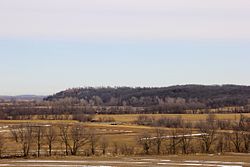Leary Site
Leary Site | |
 | |
| Nearest city | Rulo, Nebraska |
|---|---|
| NRHP reference No. | 66000449 |
| Significant dates | |
| Added to NRHP | October 15, 1966[1] |
| Designated NHL | July 19, 1964[2] |
Leary Site, also known as 25-RH-1 or Leary-Kelly Site is an
Excavations and Research
On July 12, 1804, during their expedition into the Louisiana Purchase, Meriwether Lewis and William Clark stopped along the Nemaha River. William Clark set out and noted several mounds in the area, the smaller mounds he inferred to be most likely trash pits and where homes had formerly been and the larger mounds to be burial mounds.[3]
Frederick H. Sterns, faculty the
In 1935, Strong's theory of the Oneota was evaluated by T. A. Hill, who was a member of the staff at the Nebraska Historical Society. Hill oversaw a three-week excavation at the site and was assisted by George F. Lamb and a crew of archaeologists. In the three-week period, the group of archaeologists managed to excavate 153 pits, one housing area, seven burial sites, and several scattered test pit excavations.[3] Lamb and his crew also found several projectile points that varied in color, gray, pink, white, and brown and were made of flint.[4] Two different samples of burnt pottery were sent to the University of Wisconsin for radiocarbon dating. The sample of pottery dated to 1210 AD and 1350 AD.[5] In 1939 the University of Nebraska Archaeological Survey excavated two pits.
In the late 1950s George A. Agogino and a crew of excavators went out to the site to dig test pits. Agogino at the time of the excavation taught anthropology course and the
Oneota People
The Native American village was once inhabited by people of the Oneota tribe. The Leary Site in one of the further western sites of these people. The subsistence of the people of this site was partly horticulture and partly from hunting bison.[7] The people of the village used many tools made of both stone and parts of animals. Scrapers and other tools were we most often used by women.[8] The Nebraska State Historical Society excavated a mule deer antler that had been used as a scraper.[9]
Artifacts Today
Many of the documents, research, and artifacts of the excavations of 1926, 1935, 1965, and 1979 are curated by the Archaeology Divisions of the
Historical Landmark Status
The Leary site was declared a National Historical Landmark in 1964.[10] Though the site is not open to the public, there is a plaque on a brick marker to commemorate the site as a National Historical Landmark.
References
- ^ "National Register Information System". National Register of Historic Places. National Park Service. January 23, 2007.
- ^ "Leary Site". National Historic Landmark summary listing. National Park Service. Archived from the original on March 11, 2009. Retrieved May 6, 2008.
- ^ a b c d e f Ritterbush, Lauren (2002). Leary Site Revisited: Oneota and Central Plains Tradition Occupation Along the Lower Missouri. Plains Anthropologist.
- S2CID 163439194.)
{{cite journal}}: CS1 maint: multiple names: authors list (link - ^ Bender, Bryson, Baerres (1967). University of Wisconsin Radio Carbon Dates III. University of Wisconsin.
{{cite book}}: CS1 maint: multiple names: authors list (link) - ^ Agogino, George A. (1961). A Middle Prehistoric Burial from Laramie Wyoming. Plains Anthropologist. pp. 202–204.
- S2CID 126521206.
- .
- JSTOR 3796602.)
{{cite journal}}: CS1 maint: multiple names: authors list (link - ^ "National Register Information System". National Register of Historic Places. National Park Service.
Further reading
- Hill, A.T., and Waldo R. Wedel. "Excavation at the Leary Indian Village and Burial Site, Richardson County, Nebraska". Nebraska History Magazine 17.1 (1936).
